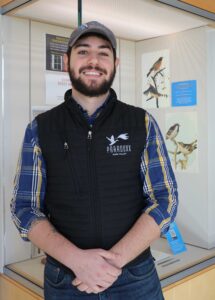Student Spotlight

Michael Tambascio and his research “For the Birds”
As spring begins to reemerge in Connecticut, one of the first hopeful signs is the return of songbirds making their presence known. For Western Connecticut State University senior Michael Tambascio, the sound is especially welcoming because for many years, he was unable to distinguish the calls of different birds. Tambascio, of Danbury, is hearing-impaired, and until he was fitted with the latest technology in hearing aids, he was unable to detect the subtle differences in the songs of different avian species.
“Once I got my new hearing aids, I began to be able to recognize specific bird calls for the first time in my life,” Tambascio explained. “This led me to want to learn more about birds and ornithology.”
Fortunately for Tambascio, he was already a student at WCSU when his enhanced hearing awakened his interest in birds. He met Professor of Biology Dr. Theodora Pinou, and she encouraged him to pursue his new-found interest. To that end, Pinou showed Tambascio several preserved birds that were held in freezers in the university’s Science Building. The birds had been discovered on the ground after having collided with the Science Building so severely that they had died.
Tambascio was intrigued and wanted to learn more. Through Pinou’s connections at Yale University, he was introduced to Kristof Zyskowski, the collections manager in Vertebrate Zoology, Mammalogy and Ornithology at the Yale Peabody Museum. “Kristof and his students at Yale taught me how to do taxidermy on birds,” Tambascio said. “Since learning from them, I’m now able to perform taxidermy in a lab at WestConn’s Science Building, and I’ve already worked on 14 birds, including a cedar waxwing, American robin, house finch and dark-eyed junco.” Seven of the specimens he’s prepared so far are part of an informational display he has created to share his growing knowledge with others.
During his time at WCSU, Tambascio has gone from differentiating bird calls for the first time to investing his time and energy to protect birds from unnecessary deaths. He cited the 2014 Loss et al. article, “Bird–building collisions in the United States: Estimates of annual mortality and species vulnerability,” which showed that up to one billion birds die per year from window collisions in the United States. A late 2023 Wilson Journal of Ornithology study similarly concluded that between 621 million and 1.7 billion birds die annually in the U.S. because of building strikes.
Tambascio also recounted with concern an October 2023 incident when at least 1,000 warblers died after colliding with a single building in Chicago. Closer to home, news reports in February 2024 revealed that Flaco, the Eurasian eagle-owl that escaped from the Central Park Zoo last year, met an untimely demise after a collision with a building.
“I want to make people more aware of bird-building collisions,” Tambascio said. “Not just to point out the problem, but to demonstrate solutions like window covers, blinds, or paint on the windows to break up the reflectivity of the light and clearness of the glass so it isn’t as confusing to birds.”
Tambascio has taken action and created an informational exhibit with support from Professor of Art Jack Tom and the WCSU Foundation Board of Directors, which funded the project through the createchnology grant. “Professor Tom was the one who helped me with getting my message across with the exhibit display set-up and details” Tambascio said.
Tambascio added that in the excitement over the recent unveiling of the new Berkshire Hall Student Center on the Midtown campus, it wasn’t lost on him that the wide expanse of glass that creates a welcoming environment for students also has the potential to be devastating to birds.
“I’m working to propose some mitigation options to prevent this,” he said. “This is important, because window collisions create a loss of biodiversity, birds are an important environmental indicator, and because birds are beautiful and an important part of the aesthetic quality of our day and our lives.”
To learn more about Tambascio’s efforts to prevent bird strikes, visit https://www.inaturalist.org/projects/connecticut-bird-window-collisions or check out Tambascio’s display in the cabinet outside Room 125 of the Science Building on the Midtown campus.

